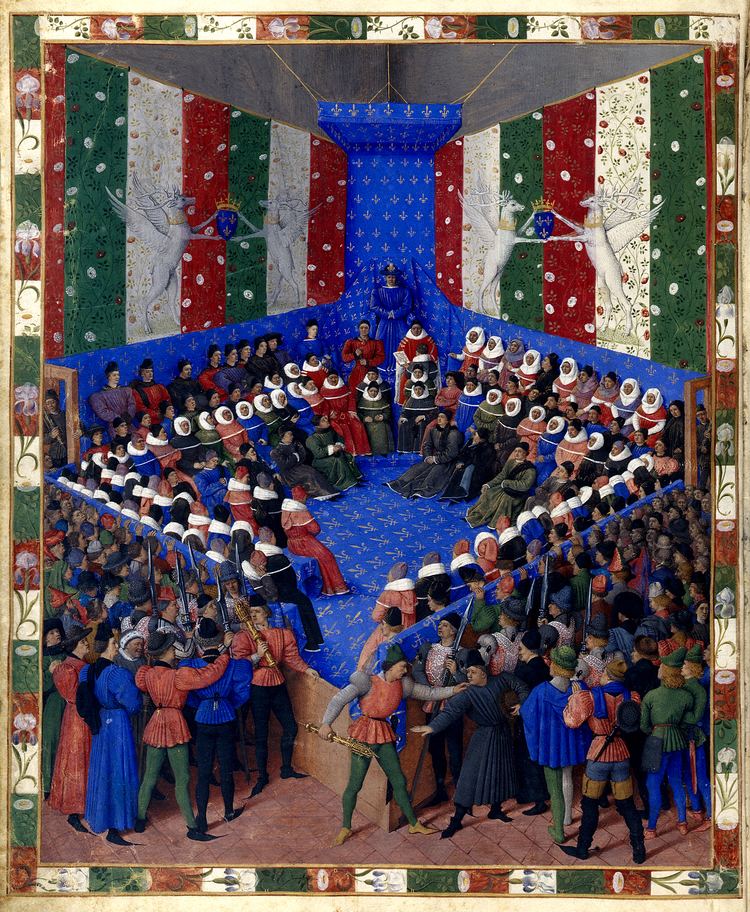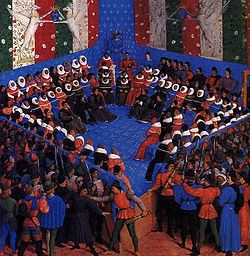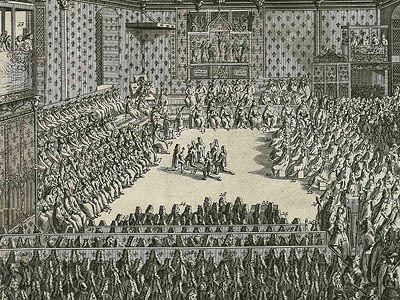 | ||
Lit de justice 1996 breeders cup sprint
In France under the Ancien Régime, the lit de justice ([li də ʒystis], "bed of justice") was a particular formal session of the Parlement of Paris, under the presidency of the king, for the compulsory registration of the royal edicts. It was named thus because the king would sit on a throne, under a baldachin. In the Middle Ages, not every appearance of the King of France in parlement occasioned a formal lit de justice. It was the custom of Philip IV and his three sons, of Charles V, of Charles VI, and of Louis XII to attend sessions of various parlements regularly.
Contents
- Lit de justice 1996 breeders cup sprint
- Breeders cup sprint 1996 lit de justice
- Description
- Later practice
- References

Breeders cup sprint 1996 lit de justice
Description

A lit de justice in Paris was normally held in the Grand Chambre du Parlement of the royal palace on the Île de la Cité, which remains the Palais de Justice even today. The king, fresh from his devotions in Sainte-Chapelle, would enter, accompanied by his chancellor, the princes du sang, dukes and peers, cardinals and marshals, and take his place upon the cushions on a dais under a canopy of estate (the lit) in a corner of the chamber.

The records of a lit de justice of Charles V, May 21, 1375, gives an impression of the panoply of personages: the Dauphin, the duc d'Anjou brother of the King, the Patriarch of Alexandria, 4 archbishops, 7 bishops, 6 abbots, the rector and several members of the University of Paris, the Chancellor of France, 4 princes of the blood, several comtes and seigneurs, the Provost of Merchants and the echevins of the city of Paris, "several other wise and notable folk and a great crowd of people".

Five cushions formed the lit: the king sat on one, another formed a back, two more supported his arms and a cushion lay under his feet. Peers and prelates were ranged on benches at his right and left. Before the king, a large space was kept empty, that the king might discuss matters privately. To preserve order, it was forbidden for anyone to leave his seat or approach the lit without being called.

The king needed only speak a few preliminary words, followed by the formula mon chancelier vous dira le reste ("my chancellor will tell you the rest"), whereupon the chancellor seated at his feet would read aloud the rest of the royal declaration, such as the declaration of a regency or of a king's majority, or declarations of war or peace. The lit de justice equally served to cow recalcitrant parlements, imposing the sovereignty of the king.
Later practice
In the Middle Ages, a lit de justice was the setting for trials of great aristocrats for major crimes. In the 16th century, it began to be manipulated for enforcing the registration of royal edicts. In the 17th century, it was rarely used but was revived under Louis XV, raising controversy among the parliamentary noblesse de robe, mindful of their threatened prerogatives.
The lit de justice, as it was revived in 1527, was intended by the royal party as an expression of royal justice, with hazy and immemorial antecedents in the open-air gathering of nobles presided over by enthroned Merovingian kings. In the king's presence the Parlement lost its usual quality of judge, to take the role of counsellor following the principle adveniente principe, cessat magistratus ("with the arrival of the king, magistratures cease"). As relations between Henri III and the Parlement of Paris became strained, the king used his presence in the lit de justice to enforce his will upon a recalcitrant court.
Absolutist propaganda asserted that a lit de justice in its origins could take place before any parlement though, in practice, the appearance of Charles IX before the parlement of Rouen to enforce the enregistration of his Edict of Amboise (1563) was an innovation intended to discount the legislative role of the Parlement of Paris. He and the Queen Mother made a tour of parlements— Dijon, Toulouse, Bordeaux, Toulouse— to enforce the registration of the Edict throughout France. From the reign of Louis XIII it was confined to the Parlement de Paris.
In his Memoirs, the Duc de Saint-Simon describes in detail a lit de justice held during the Regency of the Duke of Orléans on August 26, 1718 at the Tuileries Palace. The lit was used to enact an edict respecting the French currency over Parlement's objection as well as stripping the Duke of Maine of his control over the child King Louis XV's education and of the rank of prince du sang.
The last such session was in 1787, under Louis XVI, at Versailles. The whole body, now "refractory, rolled out, in wheeled vehicles, to receive the order of the king."
